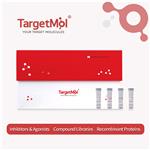[1] Chambers JM, et al. Synthesis of biotinylated episilvestrol: highly selective targeting of the translation factors eIF4AI/II. Org Lett. 2013 Mar 15;15(6):1406-9. DOI:
10.1021/ol400401d[2] Kim S, et al. Silvestrol, a potential anticancer rocaglate derivative from Aglaia foveolata, induces apoptosis in LNCaP cells through the mitochondrial/apoptosome pathway without activation of executioner caspase-3 or -7. Anticancer Res. 2007 Jul-Aug;27(4B):2175-83. PMID:17695501
[3] Chen WL, et al. Silvestrol induces early autophagy and apoptosis in human melanoma cells. BMC Cancer. 2016 Jan 13;16:17. DOI:
10.1186/s12885-015-1988-0[4] Daker M, et al. Inhibition of nasopharyngeal carcinoma cell proliferation and synergism of CDDP with silvestrol and episilvestrol isolated from Aglaia stellatopilosa. Exp Ther Med. 2016 Jun;11(6):2117-2126. DOI:
10.3892/etm.2016.3201[5] Patton JT, et al. The translation inhibitor silvestrol exhibits direct anti-tumor activity while preserving innate and adaptive immunity against EBV-driven lymphoproliferative disease. Oncotarget. 2015 Feb 20;6(5):2693-708. DOI:
10.18632/oncotarget.2098[6] Wolfe AL, et al. RNA G-quadruplexes cause eIF4A-dependent oncogene translation in cancer. Nature. 2014 Sep 4;513(7516):65-70. DOI:
10.1038/nature13485[7] Wiegering A, et al. Targeting Translation Initiation Bypasses Signaling Crosstalk Mechanisms That Maintain High MYC Levels in Colorectal Cancer. Cancer Discov. 2015 Jul;5(7):768-781. DOI:
10.1158/2159-8290.CD-14-1040[8] Todt D, et al. The natural compound silvestrol inhibits hepatitis E virus (HEV) replication in vitro and in vivo. Antiviral Res. 2018 Sep;157:151-158. DOI:
10.1016/j.antiviral.2018.07.010![(1R,2R,3S,3aR,8bS)-6-[[(2S,3R,6R)-6-[(1R)-1,2-Dihydroxyethyl]-3-methoxy-1,4-dioxan-2-yl]oxy]-2,3,3a,8b-tetrahydro-1,8b-dihydroxy-8-methoxy-3a-(4-methoxyphenyl)-3-phenyl-1H-cyclopenta[b]benzofuran-2-carboxylic acid methyl ester Structure](/CAS/GIF/697235-38-4.gif)
